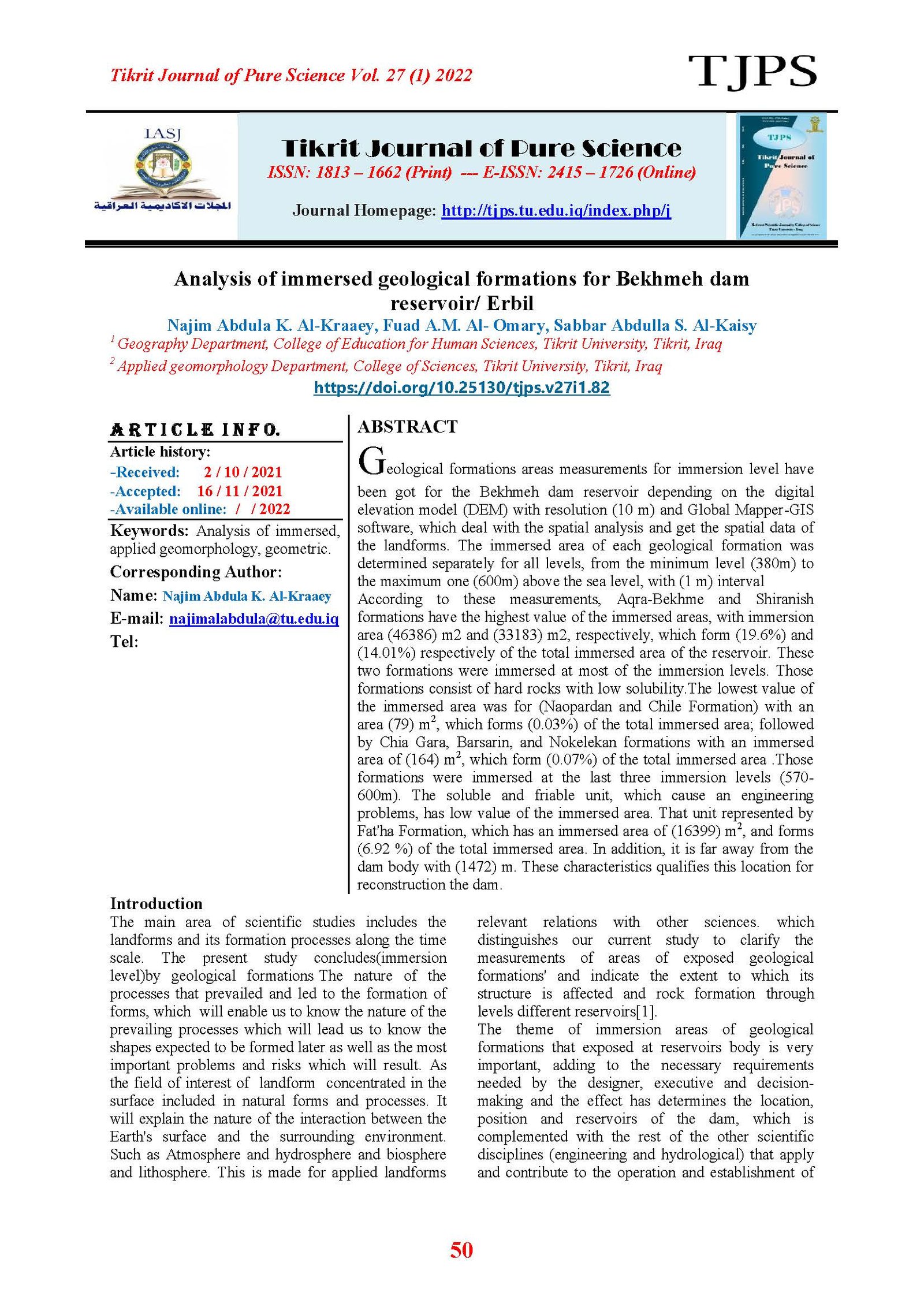Analysis of immersed geological formations for Bekhmeh dam reservoir/ Erbil
Main Article Content
Abstract
Geological formations areas measurements for immersion level have been got for the Bekhmeh dam reservoir depending on the digital elevation model (DEM) with resolution (10 m) and Global Mapper-GIS software, which deal with the spatial analysis and get the spatial data of the landforms. The immersed area of each geological formation was determined separately for all levels, from the minimum level (380m) to the maximum one (600m) above the sea level, with (1 m) interval
According to these measurements, Aqra-Bekhme and Shiranish formations have the highest value of the immersed areas, with immersion area (46386) m2 and (33183) m2, respectively, which form (19.6%) and (14.01%) respectively of the total immersed area of the reservoir. These two formations were immersed at most of the immersion levels. Those formations consist of hard rocks with low solubility.The lowest value of the immersed area was for (Naopardan and Chile Formation) with an area (79) m2, which forms (0.03%) of the total immersed area; followed by Chia Gara, Barsarin, and Nokelekan formations with an immersed area of (164) m2, which form (0.07%) of the total immersed area .Those formations were immersed at the last three immersion levels (570-600m). The soluble and friable unit, which cause an engineering problems, has low value of the immersed area. That unit represented by Fat'ha Formation, which has an immersed area of (16399) m2, and forms (6.92 %) of the total immersed area. In addition, it is far away from the dam body with (1472) m. These characteristics qualifies this location for reconstruction the dam.
Article Details

This work is licensed under a Creative Commons Attribution 4.0 International License.
Tikrit Journal of Pure Science is licensed under the Creative Commons Attribution 4.0 International License, which allows users to copy, create extracts, abstracts, and new works from the article, alter and revise the article, and make commercial use of the article (including reuse and/or resale of the article by commercial entities), provided the user gives appropriate credit (with a link to the formal publication through the relevant DOI), provides a link to the license, indicates if changes were made, and the licensor is not represented as endorsing the use made of the work. The authors hold the copyright for their published work on the Tikrit J. Pure Sci. website, while Tikrit J. Pure Sci. is responsible for appreciate citation of their work, which is released under CC-BY-4.0, enabling the unrestricted use, distribution, and reproduction of an article in any medium, provided that the original work is properly cited.
References
[1] Michael. A. Summerfield. (1991) Global Geomorphology: An Introduction to the Study of Landforms Harlow, Essex: Longman, Department of Geography, University of Edinburgh, Taylor& Francis Group,pp47-48.
[2] Al-Dulaimi, Kh. H., 2001. Applied Geomorphology. Al-Ahlia for Publishing and Distribution, Jordan, Amman, p. 228.
[3] Ministry of Water Resources, General Authority for Dams and Reservoirs, Bakhme Dam archive reports (unpublished) for the years 1942-1990.
[4] Al-Sayyab A., Al-Omari, F., Al-Ansari, N., Al-Sheikh, Z., Al-Rawi, Dh., Jassim, J.A., 1982. Geology of Iraq, Ministry of Higher Education and Scientific Research - University of Mosul, p. 377pp.
[5] Jassim, Saad Z.& Goff, Jeremy C., 2006: Geology of Iraq, Czech Republic ISBN80-7028-287-8.P35-44.
[6] Ministry of Industry and Minerals, General Establishment for Geological Survey and Mining, Geological Ages Map of Erbil and Sulaymaniyah from (VAROUJAN & SAISSAKIAN), Republic of Iraq, 1997.
[7] Al-Kubaisi, M. Sh. A., 2000. Morphotectonics of the Tigris River and its tributaries within the zone of the folds in Iraq. unpublished PhD thesis, Baghdad University - College of Science, pp. 3-34.
[8] Nouri Mohsen Hamza, N., M.,1997. Geomorphological Map of Iraq, Ministry of Industry and Minerals, General Establishment for Geological Survey and Mining, first edition, Iraq, pp. 3-23.
[9] Ministry of Water Resources, National Center for Water Resources Management, Iraq Rivers Expenses (90-2010), unpublished.
[10] Arash Barjasteh, 2012. Salt tectonics impact on dam construction in Khuzestan province of Iran. International symposium on dams for a changing world-need for knowledge transfer across the generations and the world kyoto, Japan, p25.
